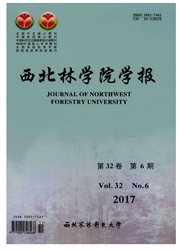

 中文摘要:
中文摘要:
为了探讨在水分和镉交互胁迫条件下,刺槐对镉的吸收代谢机理及抗氧化酶活性的变化,采用盆栽试验,研究不同水分处理(土壤含水量占田间持水量的40%、55%、70%和85%)及不同浓度的镉(10、50、100mg·kg-1)交互作用对刺槐幼苗抗氧化酶活性和丙二醛含量的影响,探究刺槐累积镉的主要部位。结果表明:在水分和镉的交互胁迫下,刺槐幼苗叶片SOD、POD酶活性呈先升高后降低的趋势,而MDA含量则逐渐升高;镉主要积累于刺槐幼苗的根部。适当的交互胁迫(10mg·kg-1镉处理,70%和55%水分处理)有利于提高刺槐的抗逆性。
 英文摘要:
英文摘要:
This paper is aimed at exploring the theory of absorption and metabolic mechanism of Cd in woody plants and the changes of antioxidant enzyme activity under interactive stress. Robinia pseudoacacia seedlings were cultivated in pots. Changes of antioxidant activity and the content of malondialdehyde were measured in the seedlings treated by different levels of water (40%, 55%, 70%, and 85%) and cadmium (10, 50, and 100 mg· kg-1). The results showed that SOD and POD activities increased at first and then decreased, MDA content increased gradually under interactive stress. Cd was mainly accumulated in the roots of R. pseudoacacia seedlings. R. pseudoacacia showed stronger resistance in the interactive stress of drought and cadmium.
 同期刊论文项目
同期刊论文项目
 同项目期刊论文
同项目期刊论文
 期刊信息
期刊信息
